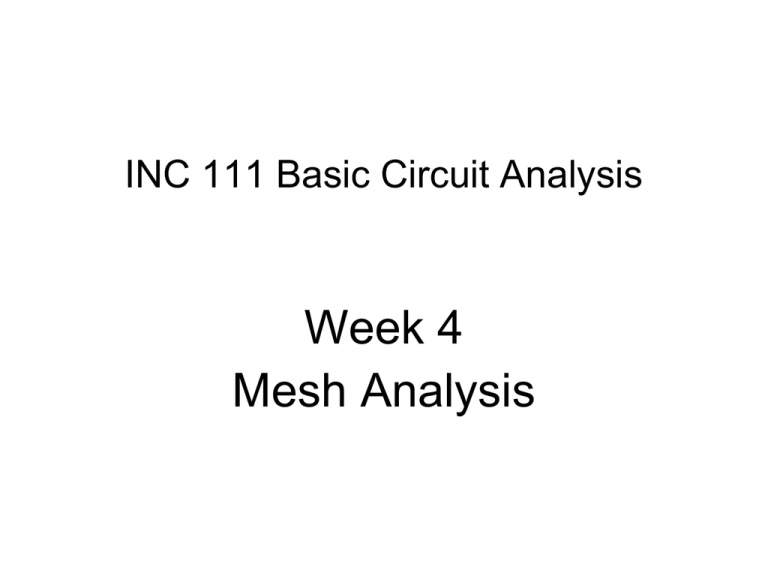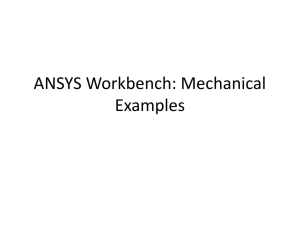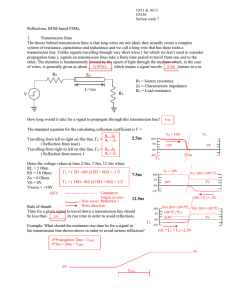Lecture 4
advertisement

INC 111 Basic Circuit Analysis Week 4 Mesh Analysis Mesh Analysis (Loop Analysis) Mesh = A closed loop path which has no smaller loops inside 5Ω 3V 2Ω 1Ω 2A Mesh Analysis Procedure 1. Count the number of meshes. Let the number equal N. 2. Define mesh current on each mesh. Let the values be I1, I2, I3, … 3. Use Kirchoff’s voltage law (KVL) on each mesh, generating N equations 4. Solve the equations Example Use mesh analysis to find the power consumption in the resistor 3 Ω 6Ω 42V I1 4Ω 3Ω I2 Mesh current (loop current) 10V 6Ω 42V Loop 1 I1 3Ω I2 10V 42 6 I1 3( I1 I 2) 0 9 I1 3I 2 42 Loop 2 4Ω Equation 1 3( I 2 I1) 4 I 2 10 0 3I1 7 I 2 10 Equation 2 I1 = 6A, I2 = 4A, The current that pass through R 3Ω is 6-4 = 2A (downward) Power = 12 W Example Use Mesh analysis to find Vx 1Ω 7V I2 2Ω + Vx - I1 3Ω 6V I3 2Ω 1Ω 1Ω 7V I2 2Ω 7 1( I 1 I 2) 6 2( I 1 I 3) 0 3I 1 I 2 2 I 3 1 Equation 1 + Vx - I1 3Ω 6V I3 2Ω 1Ω 1( I 2 I 1) 2 I 2 3( I 2 I 3) 0 I 1 6 I 2 3I 3 0 Equation 2 2( I 3 I 1) 6 3( I 3 I 2) I 3 0 2 I 1 3I 2 6 I 3 6 Equation 3 I1 = 3A, I2 = 2A, I3 = 3A Vx = 3(I3-I2) = 3V Supermesh When there is a current source in the mesh path, we cannot use KVL because we do not know the voltage across the current source. We have to use supermesh, which is a combination of 2 meshes to be a big mesh, and avoid the inclusion of the current source in the mesh path. Example Use Mesh analysis to find Vx 1Ω 7V I2 2Ω + Vx - I1 3Ω 7A I3 2Ω 1Ω 1Ω 7V I2 2Ω + Vx - I1 3Ω 7A I3 1Ω 2Ω 1( I 2 I1) 2 I 2 3( I 2 I 3) 0 I 1 6 I 2 3I 3 0 Equation from 2nd loop Supermesh 1Ω 7V I2 2Ω + Vx - I1 3Ω 7A I3 1Ω 2Ω 7 1( I1 I 2) 3( I 3 I 2) I 3 0 Equation 2 I1 4 I 2 4 I 3 7 I1 I 3 7 Equation 3 I1 = 9A I2 = 2.5A I3 = 2A Vx = 3(I3-I2) = -1.5V How to choose between Node and Mesh Analysis The hardest part in analyzing circuits is solving equations. Solving 3 or more equations can be time consuming. Normally, we will count the number of equations according to each method and select the method that have lesser equations. Example From the previous example, if we want to use Nodal Analysis 7V 1Ω V1 7V 2Ω + Vx - V2 3Ω 7A V3 1Ω 2Ω 0V Example: Dependent Source Find Vx 1Ω I2 2Ω + Vx 15A I1 3Ω 1/9 Vx I3 2Ω 1Ω I1 15 1Ω I2 2Ω 1( I 2 I1) 2 I 2 3( I 2 I 3) 0 + Vx 15A I1 I 1 6 I 2 3I 3 0 3Ω 1/9 Vx I3 Equation 1 1Ω 2Ω 1 I 3 I1 Vx 9 Vx 3( I 3 I 2) I1=15A, I2=11A, I3=17A Vx = 3(17-11) = 18V Equation 2 Equation 3 Equation 4 Special Techniques • Superposition Theorem • Thevenin’s Theorem • Norton’s Theorem • Source Transformation Superposition Theorem In a linear circuit, we can calculate the value of current (or voltage) that is the result from each voltage source and current source independently. Then, the real value is the sum of all current (or voltage) from the sources. Linearity V and I have linear relationship I V Implementation When calculating the effect of a source, the other sources will be set to zero. • For voltage sources, when set as 0V, it will be similar to short circuit • For current sources, when set as 0A, it will be similar to open circuit Example 1V 1V 1Ω I total 1Ω 1Ω I1 2V 2V I1 = 1A I2 = 2A I total = 1+2 = 3A I2 Example 1A 1A 1Ω I total 1Ω 1Ω I1 2V 2V I1 = 1A I2 = 0A I total = 1+0 = 1A I2 Example Find voltage Vx 6Ω 42V 4Ω 3Ω + Vx - 10V 6Ω 42V 4Ω 3Ω + Vx - (3 || 4) (12 / 7) Vx ( 42V ) 42 42 6 (3 || 4) 6 (12 / 7) 9.333V 6Ω 4Ω 3Ω + Vx - 10V (6 || 3) 2 Vx (10V ) 10 10 (6 || 3) 4 24 3.333V 6Ω 42V 4Ω 3Ω + Vx - Vx Vx( 42V ) Vx(10V ) 9.333 3.333 6V 10V Superposition and Dependent Source Dependent sources cannot be used with superposition. They have to be active all the time. Example Use superposition to find Ix Ix 2Ω 10V 1Ω 3A 2Ix + - Find Ix by eliminating the current source 3A Ix 2Ω 10V KVL 1Ω 2Ix + - 10 2Ix 1Ix 2Ix 0 Ix(10V ) 2 Find Ix by eliminating the voltage source 10V Ix+3 Ix 2Ω 1Ω 3A KVL outer loop 2Ix + - 2 Ix 1( Ix 3) 2 Ix 0 Ix(3 A) 0.6 Ix 2Ω 10V 1Ω 3A 2Ix Ix Ix(10V ) Ix(3 A) 2 (0.6) 1.4 A + -











